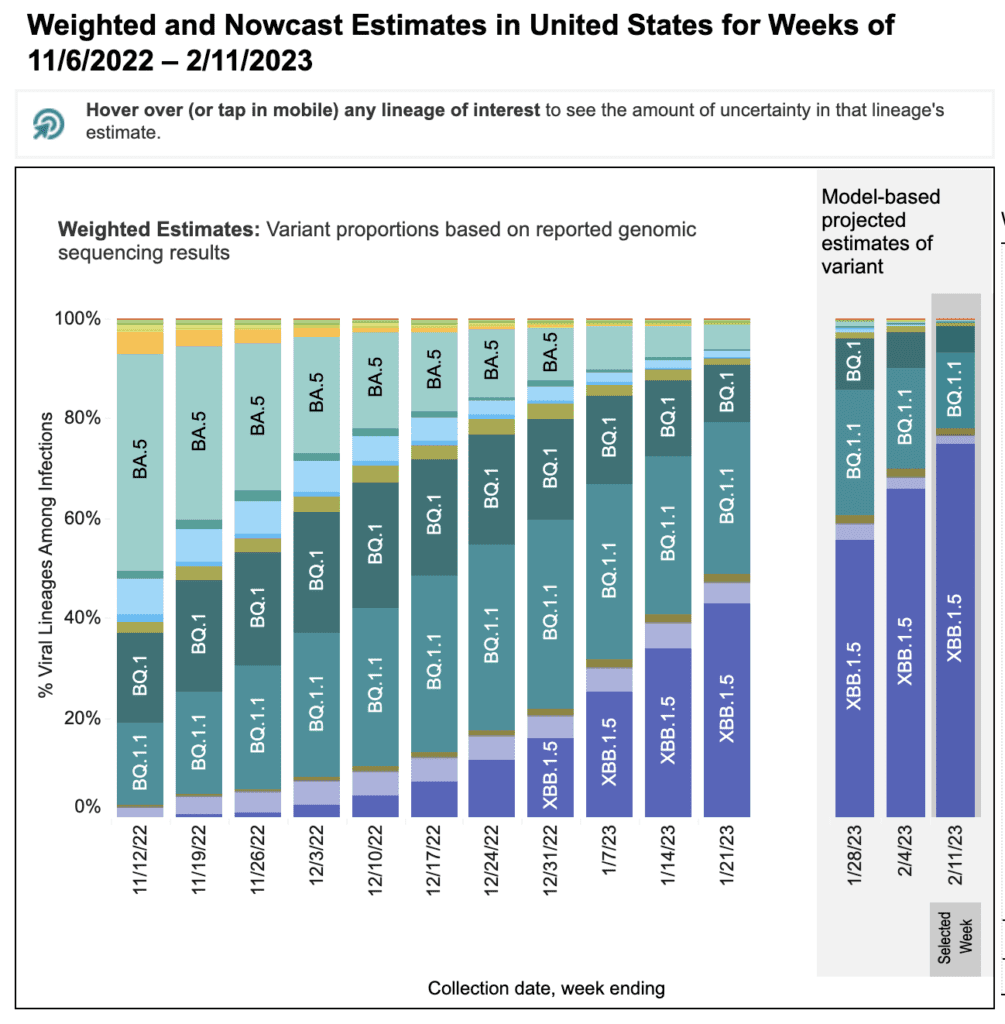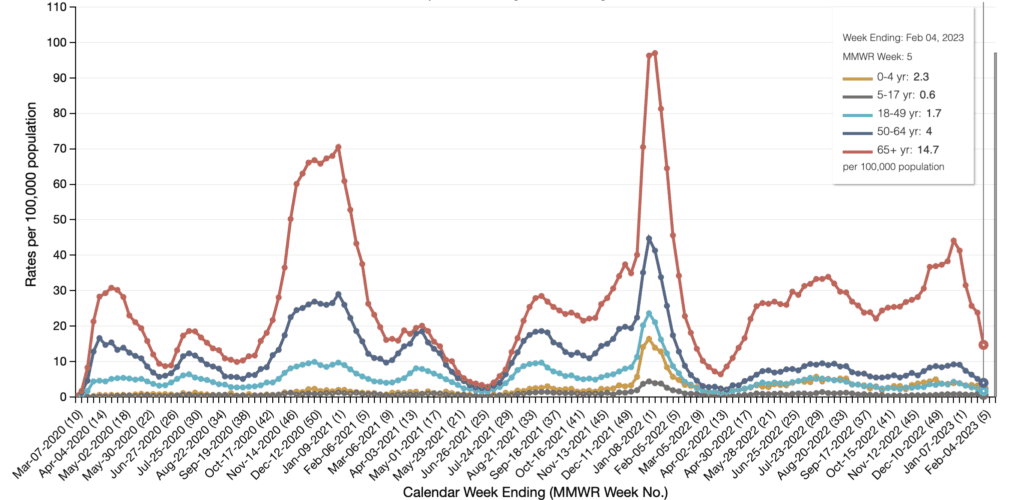El clima: Transmission levels stay stubbornly high, with 94.44.% living in areas with substantial or higher transmission. Rates are higher generally in the South, parts of the Midwest and the East Coast, with lower levels seen in the West.

Sobre variantes: El increase in Kraken (XBB1.5) cases continues to rise – 74.7% of cases this week, in comparison to 66.4% last week. The instances of BQ variant cases continue to decrease.

Regional differences continue. Kraken is almost the only strain in the East, and is still gaining rapidly in other regions over BQ1/1.1.

Monitoreo de aguas residuales: There are slight increases in wastewater levels in the Midwestern and Southern regions, but nationally levels continue to be leveling off. However, the numbers are all still high, showing that the risks of COVID are far from over.

A committee from the National Academy of Sciences recommended continued funding of wastewater collection but it is not clear how the report will be used for specific funding decisions.
Hospitalizaciones: Hospitalizaciones for confirmed COVID cases continue to decline this week, but are still far above the lowest points seen since the beginning of the pandemic.

Fallecidos: The week of February 8, at least 3,171 people died of COVID nationally. In 2023, at least 21,378 people have already died due directly to COVID.
Researchers found that hospitalized COVID patients taking Paxlovid were 35% less likely to die than those that did not, but were unable to achieve statistical significance, as non-Paxlovid patient mortality was lower than expected.
David Wallace-Wells and workers at the NY Times visualized a model-based prediction of extra deaths last year, finding that almost 50 percent more people died than would have without COVID.

Covid Largo: Un estudio found that in white, middle-aged, female individuals, so-called “healthy BMI” and sleep duration were associated with reducing long COVID risk by about 15%.
This study suffered from demographic narrowness limiting generalizability. Further research is needed to understand risk factors of Long COVID among other population groups in order to properly identify racial and ethnic disparities.
Vincent Mor makes a comparison of Long COVID with stroke recovery, where it’s known that material economic conditions make large trajectory differences; given the number of folks with long COVID, this will be yet another mechanism increasing inequality.
Treatments: Un estudio found that VV116, an oral antiviral developed in China, has fewer adverse events than Paxlovid and is otherwise equivalent, showing that exceptional societal cost to US medicine is not necessarily borne out in exceptional medications.
There is some evidence that a developing interferon injection might reduce likelihood of severe COVID outcomes, but due to small sample size and lack of high effect strength evidence is not very strong and requires further research and evaluation.
A consortium of researchers associated COVID during pregnancy with increased risk of severe complications or death, both to the pregnant individual and their child. Vaccination roughly halved the risk.
A study found that Molnupiravir increases the mutation rate of COVID, likely due to it attempting to prevent COVID RNA from replicating by mutating it, but sometimes failing and instead creating viable, mutated, virions.
Vaccines: Two (1, 2) separate studies found that the UK decision to increase time between first and second dose of mRNA vaccine from 3 to 12 weeks prevented roughly 10,000 deaths.
El CDC added COVID vaccines to its youth and adult recommendation schedules, although non-federal state or local jurisdictions determine school requirements and may not heed this recommendation.
Pronóstico: In addition to the consequences of ending the PHE reported last week – losing access to Medicaid & telehealth – a pandemic-era boost to SNAP has already ended in 18 states, with the rest to follow at the end of February.
The government will also likely fail to prevent drug companies from raising the price of mRNA vaccines to more than $110 a dose, creating further disparate impact to those who have insurance and those who do not.
While we await the possible end of the public health emergency, Johns Hopkins University is shutting down its influential tracker. They cite, somewhat contradictingly, both redundancy with the CDC’s tracker and the increasing insufficiency of state government reporting. This makes us even more dependent on the perversely incentivized federal government.
Tome accion: Sign up to attend our The Fault in Our SARS book launch if you’re interested in the gory details of the State’s sacrificing lives on the altar of its own power via capital.

Remind folks that masking, rather than asking disabled folks to attend events remotely, is more inclusive. In your workplace consider advocating for remote work by organizing with your co-workers.
Air Purification: Consider replicating, if possible, this tale of schoolkids being the ones they were waiting for by building their own classroom air purifiers.
Improving Masks: Consider making or buying a mask brace to increase the efficacy of existing surgical masks, fashioning a mask test fit kit, or perhaps use a sampler pack to find the best fitted N95.
Access to Rapid Tests: If you live in the so-called US and have health insurance, stock-up while you can on COVID rapid antigen tests, both for yourself and others; you can get 8 free tests/person every 30 days.
Consider mapping your group of personal supporters (“pod”) with this worksheet, then sharing surplus antigen tests or other COVID-protective gear with them.
Notes: 1) The numbers in this report were current as of 2/10. The CDC updates data frequently as it receives refreshed information. Today’s numbers may be slightly different from the data here. 2) Check out the links throughout & see our website for more! https://bej.gbh.mybluehost.me